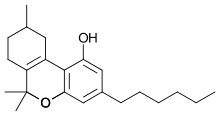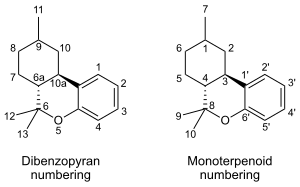Parahexyl
Parahexyl (Synhexyl, n-hexyl-Δ3THC) is a synthetic homologue of THC, which was invented in 1949 during attempts to elucidate the structure of Δ9-THC, one of the active components of cannabis.[1][2]
 | |
| Clinical data | |
|---|---|
| ATC code |
|
| Legal status | |
| Legal status |
|
| Identifiers | |
IUPAC name
| |
| CAS Number | |
| PubChem CID | |
| ChemSpider | |
| UNII | |
| Chemical and physical data | |
| Formula | C22H32O2 |
| Molar mass | 328.488 g/mol g·mol−1 |
| 3D model (JSmol) | |
SMILES
| |
InChI
| |
| (verify) | |
Parahexyl is similar in both structure and activity to THC, differing only in the position of one double bond, and the lengthening of the 3-pentyl chain by one CH2 group to n-hexyl.[3] Parahexyl produces classic cannabis agonist effects in animals. It has a somewhat higher oral bioavailability than THC itself but is otherwise very similar.[4] Presumably it acts as a CB1 agonist in the same way as THC but as there has been no research published using Parahexyl since the discovery of the CB1 receptor this has not been definitively confirmed.
Parahexyl was occasionally used as an anxiolytic in the mid-20th century, the dosage ranging from 5 mg to 90 mg.[5]
Parahexyl was made illegal under UN convention in 1982 on the basis of its structural similarity and similar effects profile to THC, despite never having had any recorded instances of recreational use by humans or illicit sale. Parahexyl was placed into the most restrictive Schedule 1 as a compound with no medical use.
Isomerism

| 7 double bond isomers of parahexyl and their 30 stereoisomers | |||||||
|---|---|---|---|---|---|---|---|
| Dibenzopyran numbering | Monoterpenoid numbering | Number of stereoisomers | Natural occurrence | Convention on Psychotropic Substances Schedule | |||
| Short name | Chiral centers | Full name | Short name | Chiral centers | |||
| Δ6a(7)-parahexyl | 9 and 10a | 3-hexyl-8,9,10,10a-tetrahydro-6,6,9-trimethyl-6H-dibenzo[b,d]pyran-1-ol | Δ4-parahexyl | 1 and 3 | 4 | No | unscheduled |
| Δ7-parahexyl | 6a, 9 and 10a | 3-hexyl-6a,9,10,10a-tetrahydro-6,6,9-trimethyl-6H-dibenzo[b,d]pyran-1-ol | Δ5-parahexyl | 1, 3 and 4 | 8 | No | unscheduled |
| Δ8-parahexyl | 6a and 10a | 3-hexyl-6a,7,10,10a-tetrahydro-6,6,9-trimethyl-6H-dibenzo[b,d]pyran-1-ol | Δ6-parahexyl | 3 and 4 | 4 | No | unscheduled |
| Δ9,11-parahexyl | 6a and 10a | 3-hexyl-6a,7,8,9,10,10a-hexahydro-6,6-dimethyl-9-methylene-6H-dibenzo[b,d]pyran-1-ol | Δ1(7)-parahexyl | 3 and 4 | 4 | No | unscheduled |
| Δ9-parahexyl | 6a and 10a | 3-hexyl-6a,7,8,10a-tetrahydro-6,6,9-trimethyl-6H-dibenzo[b,d]pyran-1-ol | Δ1-parahexyl | 3 and 4 | 4 | No | unscheduled |
| Δ10-parahexyl | 6a and 9 | 3-hexyl-6a,7,8,9-tetrahydro-6,6,9-trimethyl-6H-dibenzo[b,d]pyran-1-ol | Δ2-parahexyl | 1 and 4 | 4 | No | unscheduled |
| Δ6a(10a)-parahexyl | 9 | 3-hexyl-7,8,9,10-tetrahydro-6,6,9-trimethyl-6H-dibenzo[b,d]pyran-1-ol | Δ3-parahexyl | 1 | 2 | No | Schedule I |
Note that 6H-dibenzo[b,d]pyran-1-ol is the same as 6H-benzo[c]chromen-1-ol.
References
- Adams R, Harfenist M, Loewe S (1949). "New Analogs of Tetrahydrocannabinol. XIX". J. Am. Chem. Soc. 71 (5): 1624–1628. doi:10.1021/ja01173a023.
- Ask Dr. Shulgin Online March 7, 2001
- Ono M, Shimamine M, Takahashi K, Inoue T (1974). "[Studies on hallucinogens. VII Synthesis of parahexyl]". Eisei Shikenjo hōkoku. Bulletin of National Institute of Hygienic Sciences (in Japanese). 49 (92): 46–50. PMID 4477495.
- Fairchild MD, Jenden DJ, Mickey MR, Yale C (1980). "EEG effects of hallucinogens and cannabinoids using sleep-waking behavior as baseline". Pharmacol. Biochem. Behav. 12 (1): 99–105. doi:10.1016/0091-3057(80)90422-0. PMID 6102770.
- Supniewski, J. (1950). Farmakologia. Warsaw: PZWL. p. 89.